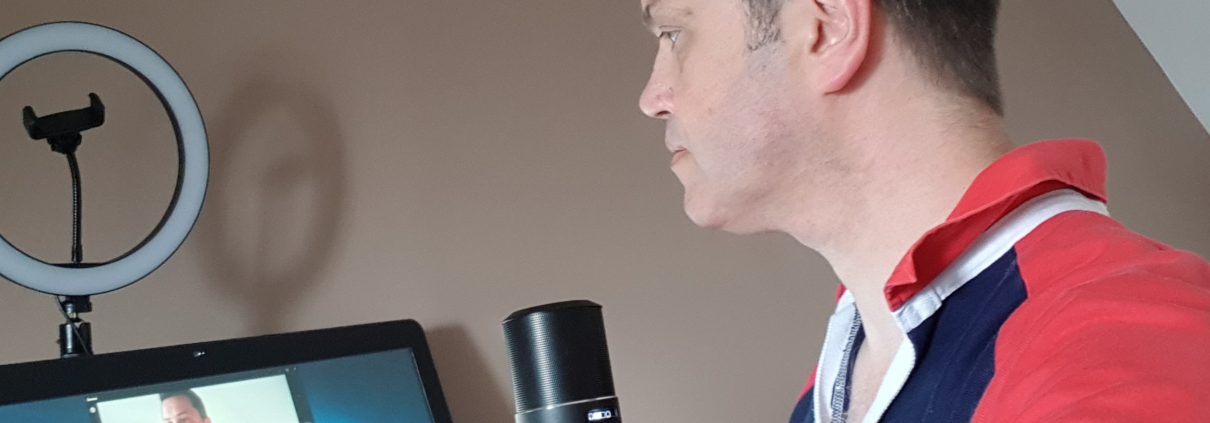Confidence and the Journey…..adapting to online IDC
Recording our own voice as audio alone or video of us singing is not something that we are used to. Many of us feel uncomfortable when we hear our own voice played back as we don’t trust the quality of our own voice and are afraid of facing it. This is bigger than anticipating hearing our own errors in pitch and timing and our bad habits we already knew about but can hide in the chorus…..this great article explains a lot – you are not alone!
Live Science – Why do people hate the sound of their own voice?
I had at least two major confidence collapses during IDC Online. The first was the worst and I splashed it all over a choir WhatsApp chat group. It lasted weeks. I pulled out of two small online choir projects and one major one; other singers were so much more capable sight-readers with great tone and singing skills. Thankfully, while I thought for short period that I should drop out of IDC online, we had a week or two break between pilot and wider choir online. Thankfully, while my fall occurred during it, it also became the means to my recovery.
It was at the time of COVID-19 presurge and many of us were fearful for our families and selves already. There was so much uncertainty in our lives. So, with this in the background, it happened after I listened back to my recordings for the first time. I had sent in my early pilot recordings, then listened to them. My voice tone was terrible and thready. Initially, I put this down to being nervous of singing in the house. I had this issue preparing for previous choral events and particularly remember it before IDC ones; my other choir met weekly, so I only had short passages I wanted to rehearse at home between choir ones, while all my rehearsal for IDC was self-led and at home – I had to learn the piece before attending IDC rehearsal events. Brian’s advice helped a lot, when you open the score for the first time, flip through the pages and note the sections, the structure, what themes recur. I knew I was a very weak sight-reader, but feel I have a decent pitch-memory, so while I can read music to an adequate level, the page is a silent mystery to me until I hear my part; I have to use online rehearsal tracks every time to crunch the notes. In my first flop of confidence in May, I thought my nerves about singing in the house and not knowing the notes were the main reasons for my terrible voice recordings, but then Brian pointed out that he couldn’t use my recording as the audio quality was so poor. Thankfully, while I was gutted, it was momentary as he pointed out that it seemed that it was very low volume, and turning it up also brought up the background noise level. I had heard my recording and thought it was reedy but that was due to my voice. However, he deduced that the mic was very far away from me. I had ‘borrowed’ my son’s gaming mic (an external USB Mic of no small expense) but sat it on the computer desk in front of me, then stood up to sing for better posture. As I am fairly tall, the mic was far from me, causing the problem. So, I looked for advice online, propped it up, changed the connecting cable and extended it, then got a mic desk clamp with an extending, flexible arm. These mics are better when held away from other desks and other things that vibrate anyway. The effect was immense. Keep your microphone close. Do beware ‘pop’, the outburst of air at the start of a plosive consonant – for example ‘p’, ‘k’ – so mic placement can help, or a clip-on ‘pop’ filter.
I had been so enthusiastic at the start and submitted recording after recording. When the gunk came and I knew the quality was very poor, looking back, another insight had happened, again from Brian; he changed headphones to good-quality noise-cancelling over-ear ones and noticed the issue. I was using my sons great Bluetooth ones that were similar. I could change from sitting to standing without being limited by the cable, but I couldn’t hear myself. When we sing in a choir, we may know the notes more or less, but we need to tune to the pitch used by the choir master and also with those around us in pitch and blend. We do this manually (*hand up* “wrong note by me, sorry sir”, *conductor points* “one of the tenors is flat on the f natural”) but we also do this ourselves note by note, actively or reflexly, auto-tuning as we hear those around us to the unison note of our voice part and to the harmony of the other voices. Online rehearsal is subject to major lag. To our ears, anything less than 200ms isn’t that significant, but our internet connections and setups mean lag is often much higher and measured in seconds. You can see it for me in the Byrd Deo Gratias video – my video is second behind the audio and this was despite Ethernet connection. So, online rehearsal means silencing everyone and generally singing to a click or notes track. So we tune to that, but we only hear our own voices within our heads when we have ‘good’ earphones on. I reverted to ear-buds and took one out so I could hear myself, the effect was painful initially as my pitching was terrible, but as I made it my norm, I got immediate pitching auto-feedback. A side effect is that if your click or notes guide track is too old in your earphones, it can be heard on your recording, especially if you have one ear bud out – keep your listening track volume low and only put one one earphone in. Tuck the other earbud somewhere discrete.
The next change was nothing to do with equipment or its set-up, but there is a priceless lesson in it. Never, ever sing in a choir or make a recording without a good warm up. Brian spends a good amount of time warming us up with articulation, projection and tonal quality exercises. In my doldrums, I looked back to before social distancing, when choirs met in person; I had rationalised that my home-singing voice was thready and my in-choir voice was less so because Brian gave us a great warm up. The issue was helped somewhat by doing my own warm up and hydrating before we started (hangovers are terrible rehearsal prep…..) but we made a Zoom record of one of our IDC warm ups for people who miss the recording and placed it on our website. I don’t use it every time, but it has helped my warm ups, and so my voice tone and range, a lot.
We can use our untrained, amateur voices to good effect by good prep like hydration and warm up (your voice and how you prepare and use it) and so it is for the quality of the amateur tools you have for recording, but it can matter even more how you set them up and use them. On the subject of prep, remember what Brian said in one of our warm-ups ‘Get your rehearsal and recording space set up first and check all is right, and only then warn up and sing; be the technician, the sound engineer, first, then put that aside and be the human instrument, the singer.”
We are not used to using to setting up and using the audio and video recording equipment well. I have gone through at least three different devices and ways to set up and have ended up improving my kit to do so.
So here are a few detailed guides, but below I have a few photos of how I am using the guidance for better results.
Making Music Resource – Recording Audio At Home
Making Music – Recording Video at Home
VirtualChoir101.com Video Tips for Singers
My setup
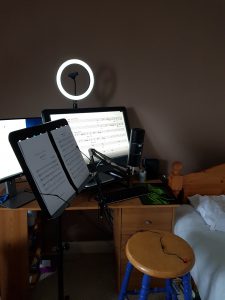 I
I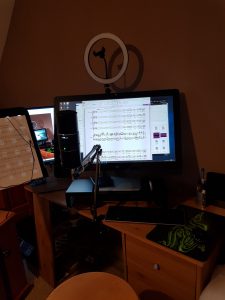
Video – Mobile phone or Webcam on PC monitor or External USB Webcam, set up high so you can stand for better singing posture and don’t look like the view of the peak the the Matterhorn from the valley below.
Audio – Mobile phone or external microphone
A stand / clamp for your microphone device to lift it close to you for better audio – desk clamp anglepoise mic stand or adjustable desk clamp mobile selfie stand
Recording Software – Audacity for Audio (free), computer camera app or mobile phone for video with audio
Lighting – Ring Fill Light on Stand – light in front of, not behind you
Music stand (though I mostly display the scores as pdf at the top of my screen just below the webcam so my eyes look towards the camera…)
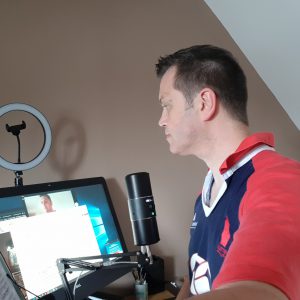
If you hold your video recording device, it shakes and distorts the audio and the video. So, I moved to using a webcam on my Computer. The computer is an all-in-one, but many monitors also have a webcam at the top of the screen surround. I am tall, so I had to raise the computer up. At times, I also prop it up even higher. I found that the light in the room meant my face was too dark for videos, so I got a little circular USB light on a stand and that works really well.
For my audio, I had the early bad issues issues I described above but also noted a few other things. I played with a propped-up mobile phone on my music stand, but in the end I had to get an anglepoise type of mic stand. You could use a mic floor stand or one like in the picture that clips onto a desk. It means I can lift it up and it stays steady when I stand. You can see a holder in the middle of the circular USB light that could hold you phone for audio / video recording or webcam for audio instead if you don’t have or want to get an external USB mic. I have to say that the external USB mic is fabulous, if sensitive, and has made a big difference to my audio.
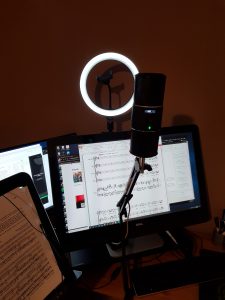
Read the guides, use what you have and move yourself and the kit around till you get better audio and visual. If you feel you still could do better, read the guides again to see what you may have missed, but maybe you need some of the kit above. External mics can be expensive (The Razer Seiren gaming one above wasn’t cheap, nor was Gareth’s Blue Yeti and webcams at High Def can also cost, but you can get reasonably priced ones too. The stands and light are not expensive and easily available online.
I know that most of you will have gone through some of the same confidence and setup issues. Healthcare professionals need to project their competence somewhat so that those they treat can have confidence in them and have faith in them. Many of us have been practising for a long time and are quite senior, so a drop in confidence in something we enjoy outside our working lives can be terrible experience. I hope you can see we can work through the issues by observation of our own selves and situations, reflecting, separating the person from the problem, drawing insights from others and our own observations, breaking down the issues and putting in place changes that help or even solve some of them, even if the amateur voice cannot be changed for someone else’s. I am not ashamed to say that this is my mix of lessons from Knuston diabetes counselling principles and my superficial interpretation of Classical Stoicism. Finally, I displayed some of my despair in our IDC Virtual WhatsApp group, but I did so as others expressed their own insecurities and troubles. That group showed me that I was not alone and helped me, when I was ready, to pick myself up again. I know that till now we have only convened in the lead up to a performance or for a workshop, rather than weekly rehearsals like many other groups, but we were due to start and our other local choirs did so too. The weekly IDC rehearsals and the chats in WhatsApp show that our choir still is a living community. I hope it helps to hear that you are not alone, maybe gives you some tips and you enjoyed the little read about my own struggles…..first world problems!
Neil

